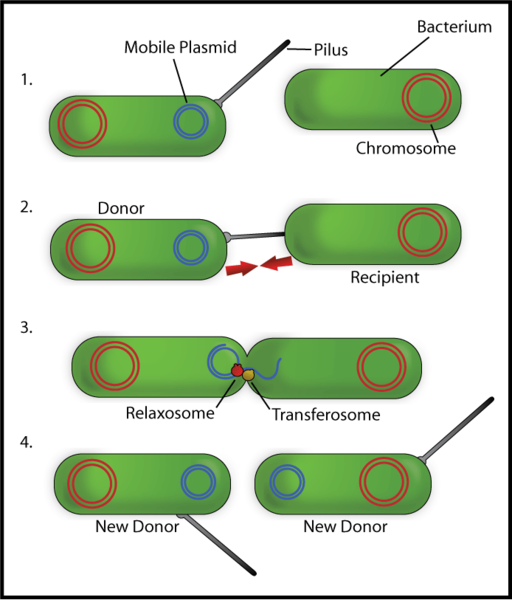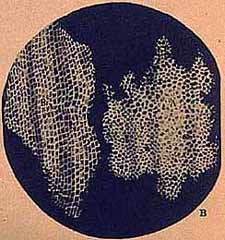Imagine you're an astronaut and have landed on a planet very much like Earth, except that there's too much cyanide in the air. Now imagine a friendly native comes up to you and says, "Oh, ho my dear Earthing from far away, no need to expire. Just shake my hand (never mind the tingling) for DNA that'll let you respire in this cyanotic quagmire." †

Believe it or not, this is exactly the life strategy employed by many bacteria (horizontal gene transfer), and that's not even the news.
Until now, we've only been able to infer how horizontal gene transfer happened. Now we can actually watch vidoes of it happening, thanks to the work of Courtney Ellison in the Brun lab at U. Indiana ref††.
Courtney developed a better way to stain and view very tiny, very important bacterial appendages called pili. Pili (singular, pilus) are long thin rods extending from the bug's body and are super useful for a lot of microbial behavior. They have 'sex' with them, can use them in attachment, and, of course, they are used by bugs to gather up environmental DNA for horizontal gene transfer. Unfortunately, I don't have the copyright privileges to directly show you the video, despite the work being publicly funded by the US NIH and NSF.††† But, I strongly urge you to follow this link the to NYT article and watch it. You can also grab the raw video file here, provided by the IU press release. Go ahead, I'll wait.

"you need to follow me right now”
-- C. Ellison to her supervisor immediately after seeing bacteria grab DNA
You just saw a bacteria reach about with a pilus and snag some potentially useful environmental DNA. How freaking cool is that?!
So much of science is patient incremental work, often with indirect inferences. It can be cool and thrilling, but it lacks the visceral feel of seeing what's going on. I can absolutely picture the moment described in the NYT article where Ellison excitedly ran into her supervisor's room immediately after her first observation.
Horizontal gene transfer
Like I wrote earlier, horizontal gene transfer itself isn't news, we've known about it since 1928 and have discovered a few methods by which it happens since then. That doesn't mean it's not super important.
For the bugs, it's a great strategy. In my previous article in this series, I mentioned that bugs who want to adapt to environments are faced with the choice of either :
- specializing and losing adaptability
- carrying the the burden of a lot of potentially useless DNA.
Horizontal gene transfer gives them a nice loophole. The DNA fragments hanging out near the bugs probably came from an organism which was adapted to the environment and there's some chance that a random fragment contains the genes which enabled that adaptation. Bugs who are able to hoover up those genes get the benefit of not having to specialize, without having to maintain their own genetic library.
This is probably a very bad strategy for an individual bug, but it works out well for them as a population. It's also, for example, how the mighty xenomorph adapts to its environment and is a way to gain powers in at least one video game.
.svg.png)
For us, horizontal gene transfer is important both as a tool and as part of battle against 'bad bugs'.
As a tool, horizontal gene transfer was a significant step towards determining that DNA, rather than proteins, were the informational basis of heredity. Beyond that, many of our methods for genetically modifying organisms are directly based on different kinds of horizontal gene transfer.
With regards to 'bad bugs', instead of cyanide, think about water or livestock awash with antibiotics. We've all heard (hopefully) of the increasing prevalance of antibiotic resistant bugs - horizontal gene transfer is the major way that they are picking up this resistance.
That's cool and all, but is it really important?
The video is beautiful in its own right and horizontal gene transfer is important, but does it actually matter that we can see it happening? I mean, we were already pretty damned certain already that pili were responsible for snagging DNA.
The answer is, resoundingly, yes, it does matter.
First of all, science is wrong all the time (and that's ok), multiple lines of evidence (especially when they involve direct observation) allow us to correct course. Second, it's a lovely video that clearly illustrates a fundamentally important bacterial lifestyle to the general public.
Most importantly, however, is that microbiology advances in lock-step with improved methods. From the development of Antonie van Leeuwenhoek's early microscope, thru fluorescent microscopy, and many other molecular methods, every observational leap increases our understanding of the microbial world.

.gif)
Indeed, if you're among the first to benefit from new methods, the discoveries to be had are almost embarrassingly low-hanging fruit. In this specific case, we can find out so many new things just by looking: how frequently does a pilus encounter DNA, does it ever reject DNA, are there specific search patterns, are some species more adept at DNA-whipping?
I myself am humbled, before this video I'd always pictured a pilus as a skinny, rigid needle, like the spine on a cactus. I had no idea how flexible and motile they could be.
Perhaps this is why so many recent Nobel prizes (1, 2,3,4,5) have gone to methods development. I am even tempted to claim that of all the disciplines, biology benefits the most from improved observational methods. (Engagement bait alert!!! I welcome counter-examples in comments).
Footnotes
† No, I don't know why friendly aliens speak in verse.
†† The official title of the article is "Retraction of DNA-bound type IV competence pili initiates DNA uptake during natural transformation in Vibrio cholerae", ostensibly because "Holy crap, are you seeing this?!" wasn't sufficiently understated.
††† If you're tired of me griping about this in my posts, imagine how tired I must be of having to deal with it.
Awesome analysis of a nature paper! As a former researcher of HGT, I'm always excited to see this field staying relevant enough to reach top tier journals. It's a shame you can't post that video as its quite a good demonstration of what's happening. I encourage everyone who missed it to check it out.
One thing to point out here is that they did all this work in the pathogen Vibrio Cholerae. This strain is a bit harder to work with than the nonpathogenic model Vibrio fisheri but was probably done to raise the importance of the work (HGT studies are only sexy if it prevents the squiring of antibiotic resistance/pathogenicity).
I'm glad you like it, and yes, hopefully people followed the video link.
I'm happy for other labs to work with BSL-2+, fisheri is pretty enough for me.
Poetry and verse are science. Or at least a version of it. Why, oh @effofex would not alien life use verse to communicate? I think that is a sound, sounds assumption. Wait and see?
You have a good point.
Hahaha. The answer may not be too far away....
You're strongly hinting that you're an alien. Come clean!
Hahaha. I'll never tell! Thanks for the compliment though!
If my science classes had been as exciting and as beautifully illustrated as this, I would have become a biologist! Although I don't completely understand bits of this post, it's a very entertaining read, and I feel as if I am witnessing evolution in action.
That's high praise indeed, I'm very glad I was able to capture your attention.
If we pay for it (NIH and NSF) then we own it--should be available. I did check out the video--creepy, sorry. I mean, miraculous but creepy. This tiny universe you microbiologists deal with is full of wily creatures, determined to survive. We underestimate that determination at our peril. Fascinating imagery--actually looked it up on another site to get an even better view.
I really like that you enjoyed it enough to find a better view. And it is creepy, but it's also awesome in the old sense of the word.
It is amazing what you can see thanks to magic of fluorescent dyes :)
For some reason, this sounds like a suggestion to ingest them. Don't do that. ;)
For your challenge: I doubt that better ways of observing something would mean a disadvantage (unless it narrows our scope down so much that we cannot see the whole picture somehow).
Nice article! Microbiology was my favorite class in my last semester. Those bugs are amazing. HGF is even more prevalent in biofilms and are curse (as you mentioned, antibiotic resistance) as well as potentially useful (living materials, nanorods for tech) and immensely important (biofilms in our intestines fighting off disease). Microbes are a topic that should get more attention. Germophodes really miss out. Cheers!
I feel sorry for thegermophobes, bugs are so much more than that.
I agree, it's almost always an advantage to have better observational ability ( though I can digress into stamp-collecting type research), but biology seems to really benefit disproportionately from such advances.
You received a 80.0% upvote since you are a member of geopolis and wrote in the category of "ecology".
To read more about us and what we do, click here.
https://steemit.com/geopolis/@geopolis/geopolis-the-community-for-global-sciences-update-4
Hi @effofex!
Your post was upvoted by utopian.io in cooperation with steemstem - supporting knowledge, innovation and technological advancement on the Steem Blockchain.
Contribute to Open Source with utopian.io
Learn how to contribute on our website and join the new open source economy.
Want to chat? Join the Utopian Community on Discord https://discord.gg/h52nFrV
Amazingly cool!
Biochemistry is often like physics, in that you're imagining things happening instead of watching them. That video brings life into what was before just an intellectual understanding. It almost looks alien. It's like we cracked the atom and we're watching inside.
The Richard Dawkins in me wonders how that's possible 🤔
Well put.
It helps to think of the population as the organism, not the individual bug. If only 10% of the cells figure out how to avoid antibiotics, but they do it faster than cells from another organism, they're going to win. This is particularly nice for organisms that are (more or less) clonal.
Yes, if they're clonal, then the game-theoretical equations allow for group selection :)
an interesting way to handle biology
Interesting reading and I am intrigued and now off to check the links
Great analogy ! After misunderstanding antibiotics-resistance, this could help me get the full image, Great post !
Glad you liked it and that it helped.
Congratulations @effofex! You have completed some achievement on Steemit and have been rewarded with new badge(s) :
Click on the badge to view your Board of Honor.
If you no longer want to receive notifications, reply to this comment with the word
STOPTo support your work, I also upvoted your post!
Do not miss the last post from @steemitboard!
Participate in the SteemitBoard World Cup Contest!
Collect World Cup badges and win free SBD
Support the Gold Sponsors of the contest: @good-karma and @lukestokes